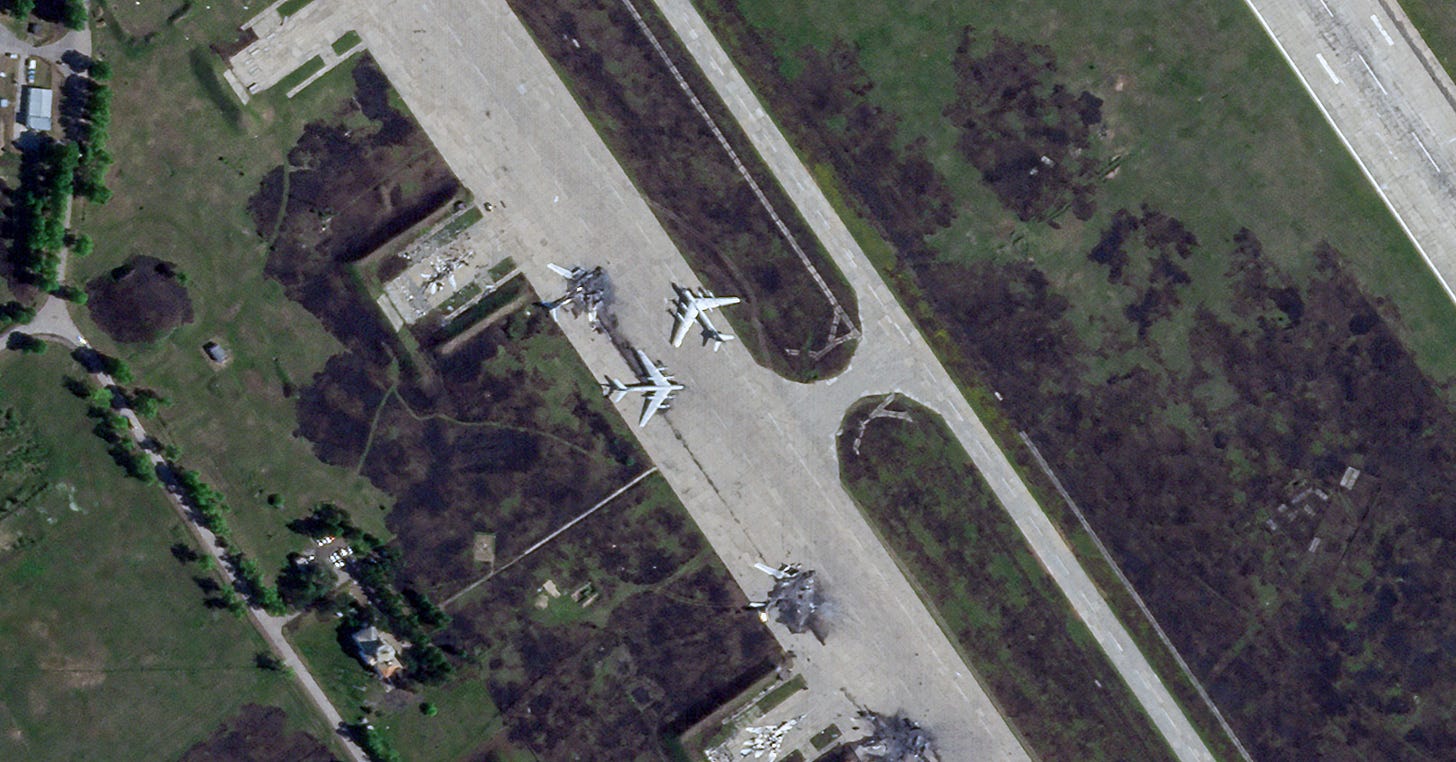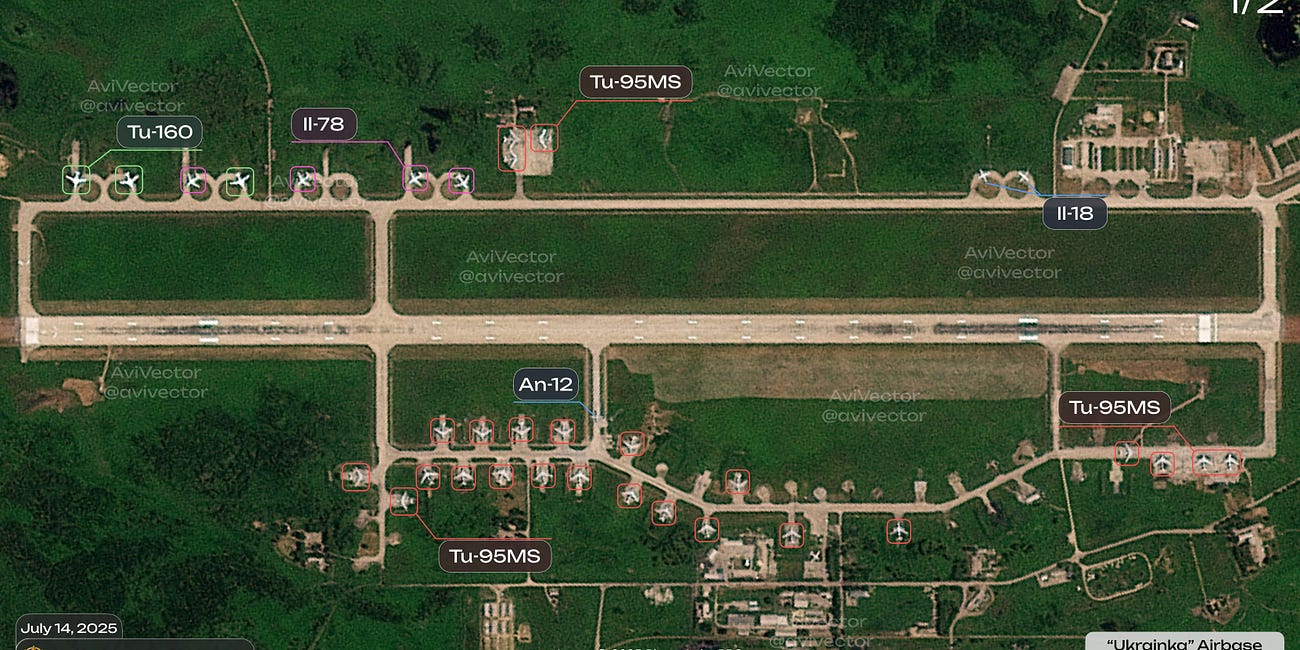Ukraine's Smuggled Drone Raid May Have Knocked Out an 8th Tu-95 Bomber
One of the giant bombers has barely moved since June 1

We know for sure that Ukraine’s June 1 drone raid targeting five Russian air bases destroyed seven Tupolev Tu-95 bombers, four Tupolev Tu-22M bombers, a Beriev A-50 radar plane and a transport plane.
But now there’s compelling evidence the raid, involving more than 100 explosive first-person-view drones smuggled across Russia in trucks, may have knocked out an eighth propeller-driven Tu-95.
If so, it’s a big deal. Pre-raid, the Russian air force possessed just 51 of the four-engine Tu-95s. But the lumbering bombers are all 35 or 40 years old—and are no longer in production. They’re complex, unreliable and supported by a dwindling industrial base.
It should come as no surprise, then, that the air force managed—again, pre-raid—to keep just 10 or a dozen of the Tu-95s in a fully flyable and combat-ready state for strikes on Ukrainian cities, according to independent aviation expert Tom Cooper.
Every Tu-95 the Ukrainians destroy or badly damage should shrink—long-term if not permanently—the pool of active airframes. By now, there may be just a handful of fully operational Tu-95s on any given day.

A stranded Tu-95
In the immediate aftermath of the June 1 raid, the Ukrainian state security service, the SBU, claimed its drones had struck around 40 warplanes at Dyagilevo, Ivanovo, Olenya, Belaya and Ukrainka air bases—respectively 310, 470, 1,200, 2,700 and 3,700 miles from Ukraine.
But close scrutiny of satellite imagery seemed to confirm just 13 losses, including 11 bombers. As the smoke cleared, the Russian air force began repositioning the surviving bombers at the major bases farthest from Ukraine. By mid-July, 40 Tu-95s were parked out in the open at Ukrainka, which escaped major damage on June 1 and, 3,700 miles from Ukraine, is probably too distant for an immediate follow-up raid.
The consolidation of the Tu-95 fleet left four of the bombers at other bases. On Wednesday, open-source intelligence analyst The Military Watch concluded that one of the Tu-95s still sitting at Olenya, 1,200 miles from Ukraine, was too badly damaged to fly.
The Military Watch had noted a scorch mark under the Tu-95 right after the June 1 raid. But “I didn't count it as damaged because I wasn’t sure whether this black smudge was caused by burnt fuel that spilled from [a] nearby destroyed Tu-95, or just soot washed down by the fire hoses.”
But five weeks later on July 8, the Tu-95 was still in the same spot. “Suspiciously long for an undamaged plane,” The Military Watch observed. Especially considering the accelerating redeployment of most of the other Tu-95s.
Three days later, crews had towed the idle Tu-95 to another spot at Olenya, “revealing rather large scorching under it,” according to The Military Watch. Two weeks later, the bomber was still there. “I’m adding it to the list as damaged,” the analyst decided.
The tally of bomber losses from the June 1 raid may now total 12—unless, of course, the Russian air force manages to repair that Tu-95 at Olenya. At the very least, the Ukrainians have reduced the Tu-95 fleet by eight for the medium term.
Some of the surviving bombers have resumed flying cruise missile strikes on Ukrainian cities, but at a slower pace compared to this spring—and an even more reduced rate compared to last year. In place of the vulnerable, hard-to-maintain bombers and their multi-million-dollar Kh-101 cruise missiles, the Russians are now launching more Shahed long-range attack drones, one of which costs a fraction as much as a Kh-101.
For the Russians, the Shaheds are a cheap and low-risk alternative to expensive, high-risk bomber operations. But there’s a downside. The Shaheds are slow and vulnerable to jamming and interception. The Russians typically launch a barrage of several hundred Shaheds once or twice a week. Typically, just 10% get through Ukrainian defenses.
That percentage may shrink. Ukraine is ramping up production of the most cost-effective air-defenses: special interceptor drones that can ram a Shahed mid-flight—and cost less than a Shahed does. The air-defense calculus over Ukrainian cities is changing … in part because Ukraine mostly removed Russia’s bombers from the equation.
Read more:
91% of Russia's Bear Bombers Are Parked Wing-to-Wing at 1 Base
In the aftermath of the June 1 smuggled drone raid that destroyed 11 Russian air force Tupolev bombers—seven propeller-driven Tu-95s and four jet-propelled Tu-22Ms—the air force might have 44 flyable Tu-95MS Bears.


